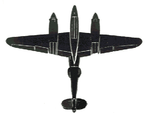Velius
Airman 1st Class
Hello everyone,
I was wondering about this the other day- what are the structural/aerodynamic advantages and disadvantages of twin boom aircraft like the P-38, Fokker G.1, FW-189, etc.?
I was wondering about this the other day- what are the structural/aerodynamic advantages and disadvantages of twin boom aircraft like the P-38, Fokker G.1, FW-189, etc.?









